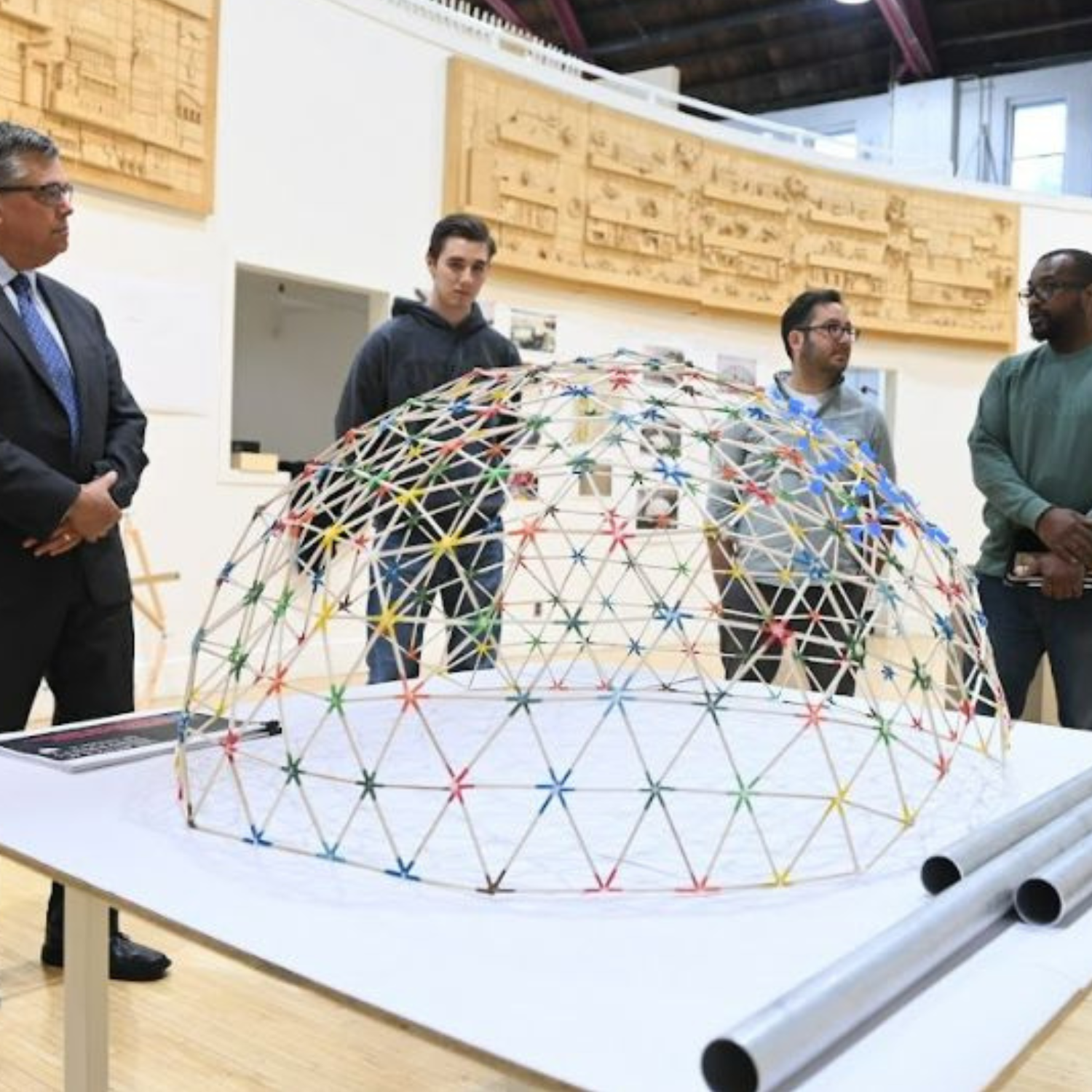Catholic University Architecture Students and Smithsonian Partner on Rebuilding Iconic Geodesic Dome Structure Inside the National Museum of American History
 Washington, D.C. (March 15, 2023) - Students from The Catholic University of America’s School of Architecture and Planning are partnering with the Smithsonian’s National Museum of American History for a once-in-a-lifetime, hands-on project to study, repair, and then rebuild a historic Buckminster Fuller dome — 50 feet in diameter and 25 feet high — inside the museum’s Flag Hall in July.
Washington, D.C. (March 15, 2023) - Students from The Catholic University of America’s School of Architecture and Planning are partnering with the Smithsonian’s National Museum of American History for a once-in-a-lifetime, hands-on project to study, repair, and then rebuild a historic Buckminster Fuller dome — 50 feet in diameter and 25 feet high — inside the museum’s Flag Hall in July.
The student build, under the direction of museum curator Abeer Saha, will begin in early July with museum visitors able to watch the construction and eventually walk through the reconstructed dome as part of the exhibition "Reconstructing 'Weatherbreak': Geodesic Domes in an Age of Extreme Weather."
The Weatherbreak is the world’s first large-span, self-supporting geodesic dome made of struts and sprits. It was built more than 70 years ago by Buckminster Fuller’s student Jeffrey Lindsay as a highly stable, efficient, and portable structure that was capable of withstanding extreme climates. Fuller was an American architect, inventor, and futurist who is credited with popularizing the geodesic dome, though he was not the original inventor.
This will be the first time the iconic structure has been reassembled since it came into the Smithsonian collections and will be the first time it will be on public view in the museum. It also is one of the few times that the museum has directly invited and involved students in a hands-on project to reconstruct and assemble an historic artifact.
Catholic University Assistant Professor Tonya Ohnstad and Lead Fabricator Lorenzo Cardim DeAlmeida are guiding the students’ work as they consider, in light of today’s extreme weather, how dome architecture should be revisited as a possible solution for affordable and resilient housing in some areas of the US and the world.
Catholic University architecture students will assemble the historic structure using its original struts along with new pieces made with sustainable aluminum of the same alloy as the original.
“Working with iconic American objects like Weatherbreak is an honor, to bring it back to life in three dimensions so the public can understand its scale and the space it creates is humbling. Accessing this piece of history as a learning tool for students is a premier learning experience,” Ohnstad said.
The dome, which is made of almost 1,000 pieces, did not come with an instruction booklet, but only a single page of color-coded strut lengths — leaving a mystery for the students to figure out. An initial surprise was discovering the pieces, or rods, came in 16 different lengths. “This project has the potential to convey that historical artifacts can inform our search for sustainable solutions in an age of climate change. Weatherbreak represents a visionary approach to building quick, affordable and sustainable shelters; one worth revisiting at a time when more than 24 million people are displaced by extreme weather events worldwide each year,” Saha said.
The students involved in the project are enrolled in an architectural history course. They are working on preliminary test builds at the Smithsonian’s Museum Support Center, visiting the museum on the National Mall, working on the fabrication of missing parts, producing models, and preparing to reassemble the entire dome in public.
“Weatherbreak was the first large span geodesic dome built in North America. Decades later, the nation and world are focused on sustainability as it relates to climate change. This living exhibition joins this urgent conversation and provides the opportunity to reconstruct and contextualize the dome for contemporary audiences, said Saha curator of engineering and project director of Reconstructing Weatherbreak at the National Museum of American History.
The prominence and National Mall location of the public build will be unmatched. Flag Hall is a central space experienced by most of the museum’s visitors and is the home of the Star-Spangled Banner, the actual flag that inspired the national anthem.
The museum has an annual visitation of four million, with July being its busiest month. Faculty and students from Washington University in St. Louis, under the leadership of Professor Wyly Brown, AIA, are working with the University and Smithsonian. Other partners include Norsk Hydro, which is donating the extruded aluminum, and Architectural Systems, Inc., which is fabricating the missing pieces.
Media contacts:The Catholic University of America:
Susan Gibbs, gibbss@cua.edu, 202-525-9554 (mobile)
Nicole Germain, germainn@cua.edu, 443-540-3121 (mobile)
National Museum of American History:
Melinda Machado, machadom@si.edu, 202-361-1266 (mobile)
